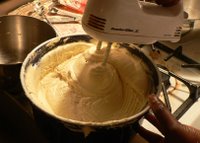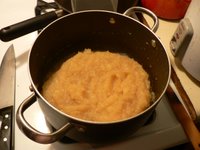3 large onions (substituting shallots for some or all if you have them)- med dice
1/2 head garlic, sliced
1.5 T paprika
3 T tomato paste (and some diced sun dried tomatoes if you have some)
5
chipotle, seeded, cut in half or chopped fine if you want to eat them
2 green
thai chili if you have them, seeded and chopped fine
dry sherry,
chinese cooking wine or light wine to
deglaze, about 1/2 cup
stock, about 1.5 cup (you can also use tomato water)
1/4 cup
ketchap manis (thick, dark sweet
indonesian soy sauce) or 2 T sugar with dark (double black or mushroom) soy equaling 1/4 cup
protein equaling about 12 largish drum sticks; well seasoned with salt beforehand. you should not salt it more than an hour before cooking it. if using tofu make sure to salt it well!
1. sautee onions in olive oil or appropriate fat until translucent (season with salt), add the garlic (season with salt) and cook until onions are brownish and you have a slight fond. dont burn it.
2. add tomato paste, paprika and chiles. cook for another several minutes adjusting heat to avoid burning. season with some more salt.
3. deglaze with alcohol making sure to clean the bottom of the pan.
4. add the other ingredients except the protein. depending on the length of cooking time for your protein you should let the sauce cook and meld, adjusting salt as needed. tofu and fish take little time to cook. you can brown your protein but with the dark soy and tomato paste i usually don't.
5. once your sauce is brought up to a near boil taste and reseason. you can then add whatever it is you're adding. i like using drumsticks or pork shoulder. comercial meats and some varieties of tofu let off a lot of water others don't so you may need to add more stock, you can always reduce the sauce by itself at the end.
6. you can braise or just briefly cook food in this sauce. tender beef, tofu and seafood would be very short. Chicken has to be cooked through but is still pretty fast. Tough meat requires true braising and could take many hours.
7. once cooked you may do several things. you can strain the sauce, blend it, blend and strain or leave as is. if youve left seeds in your peppers you may very well want to strain it. You can also saute veggies and toss in the sauce and cook briefly to let it meld. make sure to adjust seasoning, veggies give off lots of water. I like to saute onions, bell pepper and sliced garlic and toss it.
8. with any real braise the food is usually best the next day while spending the night emersed in its sauce. degreasing is often useful, when i deskin/fat chicken before cooking i dont bother. otherwise and easy method is to put the meat in the container large enough for everything. put the sauce in another contain with a narrow mouth and let it sit, seperate and congeel in the fridge for an hour or two. defat it, let the sauce come to room temp or heat it and pour it over the meat. deep fried, frozen and pressed tofu would probably benefit greatly from letting it sit over night.
9. as veg i think thinly sliced celery, sliced galic and med-small diced vidalia would be delicious.










